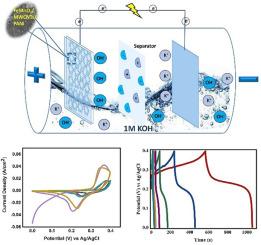钙钛矿- femno3 /MWCNTs/聚苯胺复合材料作为超级电池高效电极的研制
IF 8.9
2区 工程技术
Q1 ENERGY & FUELS
引用次数: 0
摘要
锰基混合金属氧化物具有成本效益和宽电压范围,使其具有电化学储能的前景。然而,它们的导电性差,在循环过程中结构不稳定,以及电解质溶解。通常添加导电聚合物来解决这些问题,以提高电导率和离子传输。然而,这些聚合物在循环过程中经历体积变化(收缩和膨胀)。加入碳纳米管(CNTs)可以提高结构稳定性,防止降解并保持电极的完整性。本研究采用简单的水热法合成了FeMnO₃,并将其与多壁碳纳米管(MWCNTs)和聚苯胺(PANI)结合形成三元杂化复合材料。采用傅里叶变换红外光谱(FTIR)、x射线衍射(XRD)、场发射扫描电镜(FESEM)、热重分析(TGA)、布鲁诺尔-埃米特-泰勒(BET)和x射线光电子能谱(XPS)等技术对合成的三元杂化物进行了表征。采用循环伏安法(CV)、恒流充放电法(GCD)和电化学阻抗谱法(EIS)对三元杂化物作为储能装置电极材料的电化学性能进行了评价。结果表明,在电流密度为1 a /g的情况下,三元复合材料的比容量高达1415C/g,电荷转移电阻(Rct)为2.96 Ω,在10000次充放电循环后仍保持88%的初始容量,具有优异的耐久性和性能。此外,在能量密度(Ed)和功率密度(Pd)分别为15.11 Wh/kg和130.05 W/kg的双电极体系中,三元杂化材料在1 A/g下的比容量为109.87C/g。本文章由计算机程序翻译,如有差异,请以英文原文为准。

Development of perovskite-FeMnO3/MWCNTs/PANI hybrid as an efficient electrode for supercapattery
Manganese-based mixed metal oxides are cost-effective and have a wide voltage range, making them promising for electrochemical energy storage. However, they suffer from poor electrical conductivity, structural instability during cycling, and electrolyte dissolution. Conductive polymers are often added to address these issues to improve conductivity and ion transport. However, these polymers undergo volumetric changes (shrinkage and swelling) during cycling. Incorporating carbon nanotubes (CNTs) enhances structural stability, preventing degradation and preserving electrode integrity. In this study, FeMnO₃ was synthesized via a simple hydrothermal method and combined with multiwalled carbon nanotubes (MWCNTs) and polyaniline (PANI) to form a ternary hybrid composite. The synthesized ternary hybrid was characterized using several techniques, including Fourier-transform infrared spectroscopy (FTIR), X-ray diffraction (XRD), field emission scanning electron microscopy (FESEM), thermogravimetric analysis (TGA), Brunauer-Emmett-Teller (BET) and X-ray photoelectron spectroscopy (XPS). The electrochemical performance of the ternary hybrid as an electrode material for energy storage devices was evaluated using cyclic voltammetry (CV), galvanostatic charge-discharge (GCD), and electrochemical impedance spectroscopy (EIS). The results demonstrated that the ternary hybrid achieved a high specific capacity of 1415C/g at a current density of 1 A/g, along with a low charge transfer resistance (Rct) of 2.96 Ω, and retained 88 % of its initial capacity after 10,000 charge-discharge cycles, indicating excellent durability and performance. Moreover, the ternary hybrid showcases the specific capacity of 109.87C/g at 1 A/g in a two-electrode system with energy density (Ed) and power density (Pd) of 15.11 Wh/kg and 130.05 W/kg, respectively.
求助全文
通过发布文献求助,成功后即可免费获取论文全文。
去求助
来源期刊

Journal of energy storage
Energy-Renewable Energy, Sustainability and the Environment
CiteScore
11.80
自引率
24.50%
发文量
2262
审稿时长
69 days
期刊介绍:
Journal of energy storage focusses on all aspects of energy storage, in particular systems integration, electric grid integration, modelling and analysis, novel energy storage technologies, sizing and management strategies, business models for operation of storage systems and energy storage developments worldwide.
 求助内容:
求助内容: 应助结果提醒方式:
应助结果提醒方式:


